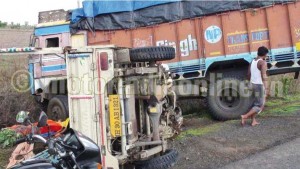
India has among the highest number of road accident casualties in the world. Every four minutes, one single life is snatched away on Indian roads. Causes for road accidents are many – the congested city roads, bad road surfaces, flooding of roads, reckless driving, inadequate traffic management and so on and so forth. More than a million people died in road accidents across India in 2001-2011.
It’s six in the morning and there is a constant drizzle. NH6 is wet, expectedly so, on a mid-June afternoon. Our aim is to cover the 300 km distance to Nagpur – 300 km away from Khamgaon, Buldhana district – before sunset.
“Good God, we have not seen any gory accidents,” claims Vijay Pawar, Deputy Manager of Mahindra Logistics. He was right. Ever since we left Mumbai four days ago in Tavera, luckily we witnessed no trucks turning turtle on the highways – both NH3 upto Dhule and then NH6 from there upto Khamgaon. No way we would have missed highway accident on these stretches since we travelled from early morning till midnight almost every single day. Given the fact that quick accident relief is an alien concept in India, nothing would have escaped our retinas: not one pair, but three pairs – mine, Pawar’s and driver Raju’s.
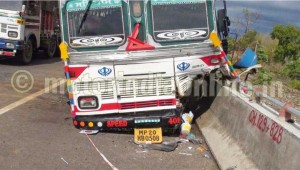
But our joy was shortlived. Soon we ran into a collision between a six-tyre Tata truck and four-tyre Tata tempo. According to locals, the mishap happened in the early hours. Obviously, the Big Boy lost control, moving towards Nagpur – and rammed into the tempo ferrying vegetables to the local mandi before sunrise.
While the drivers of tempo died before reaching the nearest civil hospital, the drivers of Big Boy tried to flee but caught by local police.
What really happened? “Lack of sleep. What else?,” pronounces someone who has taken charge to clear up the mess on behalf of the deceased tempo drivers.
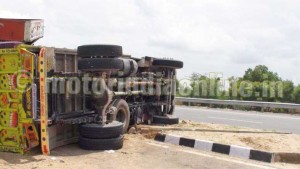
A couple of hours later, closer to Nagpur we run into another gory sight.
The vehicle MP 20 HB 0508, belonging to Nagpur Jabalpur Road Lines (NJRL), has crashed into the concrete guardrails on NH6 two days ago – again early morning, according to kids of nearby village we chat with and in the process killed an elderly villager stepping out of his home to carry out his morning ablutions! Interestingly, the owner of NJRL was unaware of the accident that his vehicle had met with until one of his business associates passing the same road found this incident and conveyed. What about driver and his assistant of this vehicle? What a question to ask? They ran away to escape from getting lynched by the mob. What’s the cause? Lack of sleep. Again.
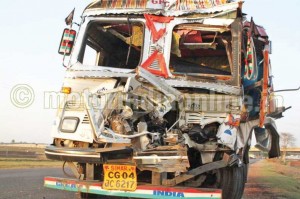
Over the 21,000 Km I had travelled in trucks on Indian highways over the past three and a half years, I understand the scene inside out. Several factors contribute to highway accidents, but sleep deprivation is a key cause. Add fatigue to this list and you’ve a ‘killer app’. Agarwal Packers & Movers Supremo Ramesh Agarwal puts it succinctly: “Do you know truck drivers are able to sleep only two and half a hour in any 24 hour cycle?”. Sleep disorder or lack of sleep is a major cause for fatigue, studies across the world confirm. When commercial drivers become fatigued from excessive daily and weekly work hours, they substantially increase the risk of crashes that result in death or serious injuries.
According to the Federal Motor Carrier Safety Administration (FMCSA), more than 750 people die and 20,000 more are injured each year due directly to fatigued commercial vehicle drivers. For this reason, the FMCSA has issued a proposed rule change to hours of service regulations governing commercial vehicle operators.
The current rule requires that commercial drivers operate a truck or bus no more than 10 consecutive hours before resting for minimum of 8 hours. This permits fatigued drivers to spend 16 hours driving in any 24 hours period. The new rule proposes a rotating schedule of work/rest based on a 24 hour period instead of an 18 hour period which requires longer rest periods for the drivers.
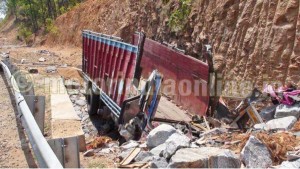
Driver fatigue is identified as a common factor for occurrence of accidents. Section 135 of the M.V. Act, 1988 prescribes that State Governments shall make schemes for (a) wayside amenities on highways (b) provide traffic aid posts on highways and (c) provide truck parking complexes along highways.
These are vital for preventing accidents on highways. Deep concern and worry about increasing number of accidents no state has carried out these essential measures for preventing accidents from taking place. Section 135 of the M.V. Act, 1988 also provides that the State Governments shall make an in-depth study on causes and analysis of motor vehicle accidents. This was intended to identify the cause so that the same could be rectified. Thus reduce recurrence.
It is official that over 80 per cent of the accidents occur on highways due to driver’s fault. It is a moot point how the driver was not responsible for the remaining 18-20 per cent cases? Further if the driver could be absolved of his role in the case of these 18-20 per cent cases, how could he be held responsible solely for the said over 80 per cent of accidents. The reason for this doubt is that hardly any driver, while steering his vehicle, normally would crash into any object or person whether on the Road or outside the road, simply for the heck of it,” argues Chittaranjan Dass, a veteran transport industry watcher for more than 50 years.
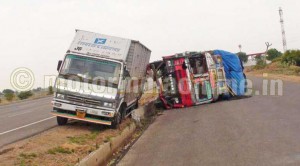
Government is not ignorant of road safety related issues. The Sub Group on ‘Road Safety & Human Resource Development’ under the Working Group on Road Transport for the 12th Five Year Plan (2012-2017) talks at length on this subject. According to this Group, the total number of fatalities increased at an average rate of about 2 per cent per year in the period 1997-2003 and the rate has increased to ~6.5 per cent per year since then. The number of fatalities per million populations remained around 79-83 during 1997-2003 and has since increased to 108.
“Road safety policies in India must focus on the following issues to reduce the incidence of road traffic injuries: … slow vehicles on highways; over-involvement of trucks and buses; night-time driving; and wrong way drivers on divided highways,” opines the Group.
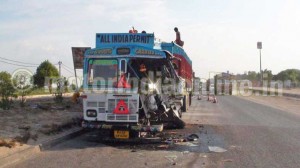
It is no secret that no company follows any rules with regard to timing. The only ‘timing’ motor maliks are concerned about is the delivery committed to the client. The hapless drivers are exposed to all kinds of weather, eat the most unhygienic food on roadside dhabas and sleep in the most uncomfortable beds inside the cabins. Yes, they do sleep past midnight and early mornings inside the vehicles parked on the roadside.
What happened to the two-driver for HCV the government was contemplating? Good question. It never found acceptance among the fleet owning fraternity. What’s their rationale? “What are you talking about? We are unable to find one driver to keep our fleet onroad and you are advocating two-drivers. Nonsensical,” tells Dilip Das, Secretary of Bongaon Lorry Owners Association and an active political acolyte of Trianamul Congress’s Chief Minister Mamata Banerjee of West Bengal.
“A commercial driver spending several nights on the road in abnormal sleeping conditions … and limited sleep will accumulate hours of sleep deprivation. If a sleep debt becomes too large, the brain will eventually go to sleep involuntarily. This is called micro-sleep,” opines Jon Beaulieu, a consultant with International Transport Federation while writing on the subject of The Issues of Fatigue and Working Time in the Road Transport Sector (2005). He goes on to add that for example, if a driver has a microsleep of just one second while travelling at a speed of 100 km/h, the vehicle will have gone 28 metres without the driver in control.
From an Indian perspective, no commercial vehicle moves at 100 km/hour speed. That’s the only saving grace. Absence of adequate and proper sleeping facilities en route is an unadulterated truth. Fighting fatigue is not unidimensional, but multidimensional: everyone ought to be involved.eet owners should make provision for en route rest and recreation.
Tom Vanderbilt, the renowned transport author writing in “Traffic: Why We Drive the We Way We Do and What It Says About Us”, hits on the nail in the general bias in any highway collision. “… our discomfort in driving next to a looming truck on a highway is some modern version of the moment of our pre-historic ancestor felt the hairs on the back of his neck raise when confronted with a large predator. Indeed, the amygdale is thought to be linked with fear”.
Daniel Blower, a researcher at the University of Michigan Transport Research Institute says, “The truck driver is the only one who that survives 85% of the time. He is the one who gets to tell the story. That is what is reflected in the police report.” His research found that in 70% of the fatal truck-car crashes, the driver of the car had the sole contributing responsibility in the crash. “The caricature that we have that the highways are thronged with fatigued, drug addled truck drivers is, I think, just wrong,” opines Blower.
On second thoughts, forget about recreation, but no compromise on rest. Government should legislate – if it has not, that is – and enforce strict adherence to working norms for transport sector. Heavy commercial vehicle manufacturers should make commercial vehicle driving long distance less cumbersome. Like Tata Prima has done it already which, drivers confess, is “designed keeping drivers’ comfort in mind”. If not immediately, the two-driver norm has to kick in at some point of time. Well, it surely is a long term wish list.